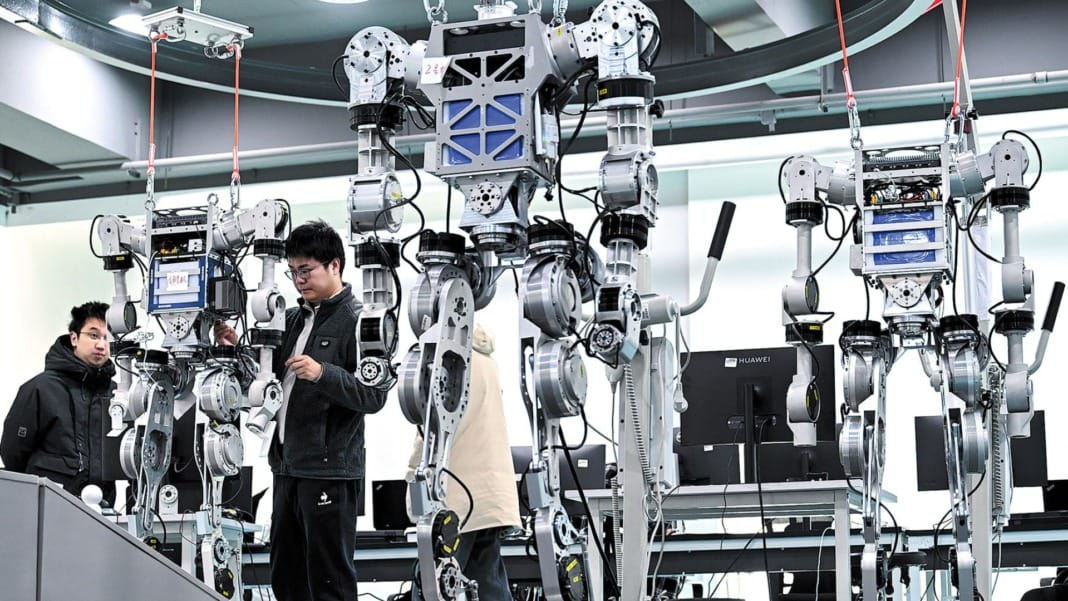By mid-2027, humanoid robots will work alongside Home Team officers in Singapore. These robots, designed for dangerous and complex tasks, will be used in firefighting, handling hazardous materials, and search and rescue operations. At first, they will be remotely controlled by humans. But by 2029, they’ll operate independently using artificial intelligence (AI), with humans stepping in only when needed.
Robots built for risky jobs
The Home Team Science and Technology Agency (HTX) is leading the development of these humanoid robots. On May 26, four of them were shown to the public at the opening of the AI TechXplore exhibition held at Fusionopolis One. This two-day event, which highlighted how the Home Team uses AI to improve its operations, was held alongside the HTX career fair, Careers@HTX.
Three of the robots are around 1.7 metres tall, while one is about 1.2 metres. To control the smaller robot, HTX engineers have built an exo-suit that a human operator wears. This suit sends signals to the robot to copy the operator’s movements in real time. The operator also wears a virtual reality (VR) headset, which lets them see through the robot’s cameras. This setup allows them to perform various tasks remotely as if they were inside the robot itself.
AI will eventually allow these robots to respond to real-world situations independently. This will let them support officers without needing constant human control. These smart machines are designed to think, move, and act independently while humans supervise from a distance.
A bold step into the future of safety
At the event, Minister for Digital Development and Information Josephine Teo announced a major investment in the future of public safety. A total of US$100 million will go into building the new Home Team Humanoid Robotics Centre (H2RC), which is expected to be ready by mid-2026. The facility, the first of its kind in the world, will focus on building humanoid robots for use in public safety. It will include spaces for gathering data, training AI models, and testing robots. High-performance computing systems will also be set up to support this work.
Mrs Teo stressed that law enforcement must keep pace as criminals become more tech-savvy. “Criminals are exploiting technology in ways never imagined,” she said. “We must also have the capabilities to use the technology to fight crime and to do better for our people.”
She added that this project marks a turning point for the Home Team. It will shift from simple programmed machines to smart robots powered by generative AI. These robots can think and act independently to help save lives and protect the public.
Enhancing the work of front-line officers
Mr Ang Chee Wee, HTX’s chief AI officer and assistant chief executive (digital and enterprise), said the new centre is a key part of HTX’s AI strategy. He explained that using robots in real-world settings will help improve how they work alongside human officers. “By putting humanoid robots in realistic environments, we can evaluate how AI can complement our officers, enhance safety, and support the long-term operational needs of the Home Team,” he said.
The Home Team has used robots before. As early as 2018, patrol robots were deployed at major events. Since HTX was formed in late 2019, development has sped up. The agency introduced the Rover-X robotic dog and even used cyborg cockroaches for search and rescue missions in Myanmar.
Drones have also become a regular part of major public events, including recent political rallies. These drones help with crowd control and other police duties.
On May 19, security company Certis announced it had received its first humanoid robot, showing that more organisations are adopting this technology.
Dr Daniel Teo, who heads HTX’s Robotics, Automation and Unmanned Systems Centre of Expertise, said the potential of robots in public safety is huge. “Public safety operations require robotic systems that are adaptable and resilient,” he said. “These AI-driven robots have a huge potential to enhance the safety and effectiveness of front-line officers.”
As Singapore advances in AI and robotics, these new humanoid robots may soon become a regular part of how you experience safety and security in the city.




